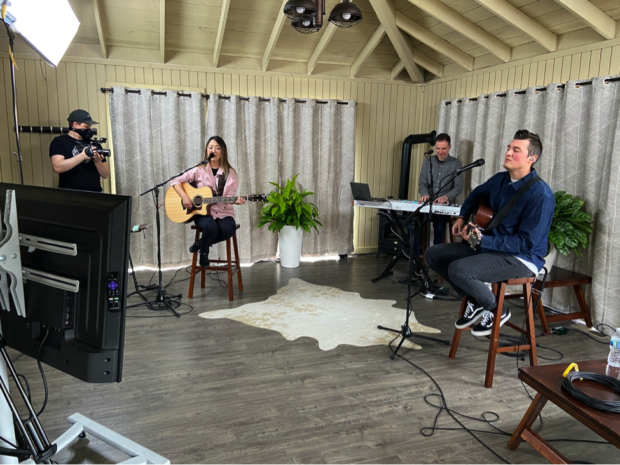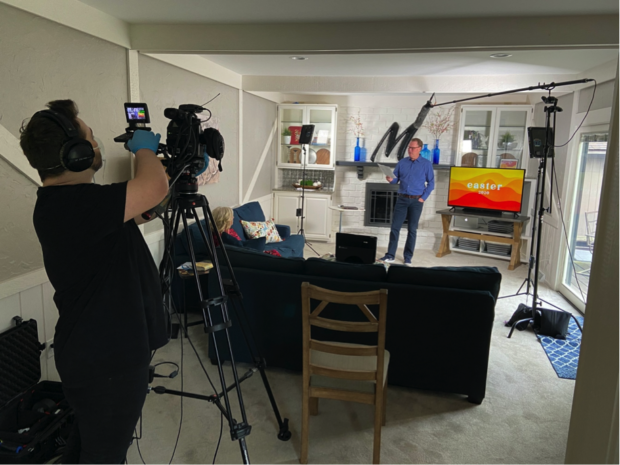Pandemic Partnerships
A Megachurch so comfortable online that it’s sharing its technological know-how with others
Kate Cammell | kac2261@columbia.edu
As churches remain shuttered in the wake of COVID-19, many have moved services online indefinitely. For some, it’s posed new technological challenges. But for Ada Bible, a 9,000-person megachurch in Grand Rapids, Michigan, the transition to virtual pastoring has been one of the more feasible parts of shifting operations.
Ada Bible has been live streaming their sermons since 2008 and it’s become an integral piece of their weekly worship model. The church has a sophisticated and salaried, eight-person production team, led by Service Programming Director, Jeff Abbott. The team is comprised of a technical director, production director, production coordinators, a live video director and a few weekend volunteers. Abbott said that “the pandemic didn’t change [Ada Bible] radically, our values stayed the same, [to] keep people connected to God and his church.”
Now they’re sharing their technological know-how with churches across the denominational spectrum. The church is donating equipment and their years of digital expertise to smaller congregations. They’ve purchased production kits for a handful of parishes that include a camera, live stream box and mics. Abbott noted, “Barriers that once separated us have helped to draw us together.”

With a trimmed beard and shoulder-length brown hair pulled into a low bun, Kyle Pierpont has an uncanny resemblance to the Western iconography of Jesus. Pierpont is in charge of the church’s pastoral care and often opens the in-person services at Ada Bible’s Cascade Campus, one of the churches four physical locations throughout the 200,000-person city of Grand Rapids.
Before the pandemic, people trickled into the auditorium in cotton tees and with cups of coffee in their hands. There was limited regard for punctuality, and between the flashing lights and pop hymnals accompanied by electric guitar, the services also have the feel of a low-budget rock concert.
The casual vibe Ada Bible cultivated in person and virtually over the years is both strategic and rehearsed. Before the pandemic, producing a weekend service took 8 to 10 people and hours of meetings between the pastors, skill development sessions with the production team and rehearsals where the pastors’ movements were blocked out on stage. Now, Ada Bible is producing the services with just two crew members socially distanced in the homes of the individual pastors.
Pierpont recorded his first virtual message to his congregants while sitting in front of the bright green frond of a banana plant his wife got from Costco. His colleagues teased him about his tropical background after Ada Bible’s first fully virtual service stream aired on March 14, 2020. But Pierpont said the hardest part about going virtual isn’t filming recorded messages, it’s been the realization of how much he relied upon the physical spaces of the church for moments of connection with congregants.
Ada Bible’s multiple-site model is similar to many megachurches across the nation. The Beck Group, an architecture and real estate company, led one of the biggest surveys of megachurches. When the study was conducted in 2015, nearly 62 percent of megachurches had multiple locations and, like Ada Bible, 40 percent identify as nondenominational. Most megachurches draw their large crowds as the result of enigmatic pastors and Ada Bible is no different. Its membership grew rapidly in the 1990s and has coalesced around Jeff Manion, the church’s Senior Pastor. He’s known for a conversational and relational preaching style, using his hands to punctuate his message and often coming near tears as he talks.
As the church’s auditorium first began to fill to capacity, people had to spill through the doors into the church atrium. Pierpont said that instead of creating a bigger auditorium the church opted for the campus model because their concern was that if you build a bigger auditorium you have to keep it occupied. “If it ever doesn’t fill up or struggles to stay full you struggle with morale issues, people wandering into a big room that feels empty even if there is a good amount of people,” he explained.
Before Ada Bible created separate campuses, leadership launched venues which were smaller rooms within the same campus building. Manion’s sermon was live streamed onto a screen from where he was preaching just feet away. There were some live elements like a host and live band, and church members could still see Manion in the hallways after the service.
Cheryl Jenkins, a 22-year member of Ada Bible and mom of three, was first attracted to the church because of Manion’s style. Jenkins began attending services in a venue known as The Studio when it opened. She said there was adjustment period at first, but the live elements helped bridge Manion’s virtual appearance.
Jenkins noted that, unlike the auditorium, The Studio has tables and chairs, and said: “It’s one of the things that I, personally, like the most. It may seem kind of silly, but it’s the truth! I enjoy the casual feel of being able to sit at a small table, while at church, take notes and have my coffee in front of me.” That relaxed feel is strategic.
Manion preaches at the original Cascade campus each week and his services are live streamed to the auxiliary locations and venues once on Saturday nights, and twice on Sunday mornings. Though it may seem unorthodox to drive to a building to watch a pastor preach live at another building, or from even just a few rooms over, approximately 5,000 people did it at Ada Bible every week pre-pandemic.
Aided by strong financial backing, many regards, Ada Bible runs like its own small production company. Now, the church is using some of its saved emergency funding to help others survive. In addition to purchasing production kits, they’re helping churches pay rent or salaries they can’t afford due to the pandemic.
The production team is also meeting with churches over zoom to help them transition. Abbott said, “I offer advice, experience and often just affirmation that their approach will work. I preach connection and care, not production quality. We have had years to develop the technical skills and the organizational skills to do what we do.”
The EDGE Urban Church in Grand Rapids is one of the parishes partnering with Ada Bible. The church reaches an underserved community and 70 percent of their resources come from the outside the church itself. They had a social media presence before the pandemic but were new to creating online sermons. Pastor Evans, The EDGE’s Lead Pastor, noted that his church “uses hip hop as our primary form of worship. It is extremely hard to translate hip hop worship through a screen.” They’re figuring out how to connect in new ways and Pastor Evans said that in this moment their “relationship with Ada has been a lifeline.”

Ada Bible is learning along with the churches they’re guiding. For the first two weeks after the church closed, the clergy recorded sermons in the auditorium, splicing each part together to follow social distancing guidelines. Beginning with their Easter weekend service, the sermons were recorded by people in their own homes. Congregants joined Manion in his pristine white marble kitchen, Teaching Pastor Aaron Buer in his entryway and a three-piece praise band in a living room positioned in a triangle composed of six feet of space between each person. Pierpont said he got positive feedback from the congregation that they liked the familiarity of the being invited into their leaders’ homes. He called it, “meeting people where they are.”
For Summer Wetherbee, a 19-year-old college freshman, that’s in her pajamas. Wetherbee grew up going to in-person services at Ada Bible each week. Now, she’s been watching their weekly services on her laptop. While she hasn’t noticed a change in quality of the sermons, she does “miss seeing the smiling faces of people every Sunday.” Scott Edwards, a 67-year retired theologian and army veteran echoed this sentiment. He watches the sermons on his iPad and, like Summer, is skipping his usual church clothes for the outfit he wears to feed his horses.
On Pierpont’s end, he’s started reaching out more to congregants to create those liminal church hallway spaces online. He emailed congregants for the first time, sending out 2,300 messages. He received nearly 160 personal replies. His email opened by saying, “I wanted to let you know I miss you, and miss connecting with you as your Campus Pastor. I am thinking of you.” The message ended with his email and phone number. It was an attempt to say to people, “hit me up, if you need something or if I can be praying for you, let me know.”
He admits he’s not sure why he wasn’t emailing people before. The church building made it easier for him not to do so, but he noted that it’s a practice he’ll be sure to carry forward post-pandemic. He confessed, “[The church] will not be the same when we get back. If we get back, when we get back—we will not be the same.”
It’s taking a lot of trial and error, but Pierpont confessed, “everyone is kind of scrambling anyway.” Ada Bible is figuring out how to apply their years of virtual intimacy creation in sermons to sustained week-long connection. “Production success is all about vision, planning, preparation, and execution,” Abbott said.
They’re bringing this same rehearsal, adaptation and intention they’ve always relied on to reimagining the church in this moment, while uplifting other congregations. And, of course, they’re throwing in a dash of an ingredient that’s harder to come by in crisis—faith.
